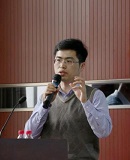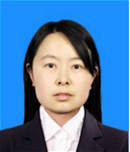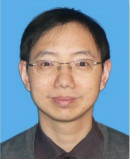Keynote Speakers

Professor Bin Zou
College of Geoscience and Information Physics, Central South University, China
Webiste: http://faculty.csu.edu.cn/binzou/zh_CN/yjgk/68318/list/index.htm
Speech Title: Deepening exposure risk services based on remote sensing enhanced air pollution mapping
Abstract: With the further research on the exposure risk of particulate pollution, the method that estimates the PM2.5 exposure based on the environmental concentration is difficult to illustrate the comprehensive status of the entire country. Contrast to the environmental concentration from monitoring sites, the population weighted exposure considering the individual exposure behavior, environmental concentration and population distribution is more suitable to be the factor of making determination on prior areas of environmental management. This research applies the related concentration of population weighted exposure model (RPWE) based on a nation scale survey of individual exposure behavior parameters (91527 individuals from 31 provinces and 153 counties) and spatial continuous PM2.5 concentration of satellite remote sensing mapping supported by big data. It shows significant difference on the related PM2.5 concentration of population weighted exposure between diverse kinds of people...
College of Geoscience and Information Physics, Central South University, China
Webiste: http://faculty.csu.edu.cn/binzou/zh_CN/yjgk/68318/list/index.htm
Speech Title: Deepening exposure risk services based on remote sensing enhanced air pollution mapping
Abstract: With the further research on the exposure risk of particulate pollution, the method that estimates the PM2.5 exposure based on the environmental concentration is difficult to illustrate the comprehensive status of the entire country. Contrast to the environmental concentration from monitoring sites, the population weighted exposure considering the individual exposure behavior, environmental concentration and population distribution is more suitable to be the factor of making determination on prior areas of environmental management. This research applies the related concentration of population weighted exposure model (RPWE) based on a nation scale survey of individual exposure behavior parameters (91527 individuals from 31 provinces and 153 counties) and spatial continuous PM2.5 concentration of satellite remote sensing mapping supported by big data. It shows significant difference on the related PM2.5 concentration of population weighted exposure between diverse kinds of people...

Professor Zhenhao Xu
Deputy Director, Urban Underground Space Engineering Department, Shandong University
Chair, Associated Research Centers for the Urban Underground Space, Youth Group (Asia)
Website: http://faculty.sdu.edu.cn/xuzhenhao/zh_CN/index.htm
Speech Title: Hazard-causing System and Assessment of Water and Mud inrush in Tunnels
Abstract: The speech covers the research and application achievements in the past years of the authors regarding hazard-causing system and assessment of water and mud inrush in tunnels. More than 300 cases of water and mud inrush are analyzed. Typical case studies are carried out. The hazard-causing system of water and mud inrush was classified into 3 categories including 11 types, and 4 typical hazard modes of water and mud inrush in tunnels are proposed. The tunnel route selection principle and assessment method in karst area are proposed based on analyzing the types, structural characteristics, macroscopic geological and engineering identification of the karst water system. An interval dynamic assessment method of water and mud inrush risk in tunnels construction is proposed. A resistance body assessment method against water and mud inrush in tunnels is established. A comprehensive identifying method for the hazard-causing system of water and mud inrush is proposed, including the geological identification, geophysical identification and drilling identification. Finally, a dynamic management and analysis platform for tunnel water and mud inrush cases is constructed.
Deputy Director, Urban Underground Space Engineering Department, Shandong University
Chair, Associated Research Centers for the Urban Underground Space, Youth Group (Asia)
Website: http://faculty.sdu.edu.cn/xuzhenhao/zh_CN/index.htm
Speech Title: Hazard-causing System and Assessment of Water and Mud inrush in Tunnels
Abstract: The speech covers the research and application achievements in the past years of the authors regarding hazard-causing system and assessment of water and mud inrush in tunnels. More than 300 cases of water and mud inrush are analyzed. Typical case studies are carried out. The hazard-causing system of water and mud inrush was classified into 3 categories including 11 types, and 4 typical hazard modes of water and mud inrush in tunnels are proposed. The tunnel route selection principle and assessment method in karst area are proposed based on analyzing the types, structural characteristics, macroscopic geological and engineering identification of the karst water system. An interval dynamic assessment method of water and mud inrush risk in tunnels construction is proposed. A resistance body assessment method against water and mud inrush in tunnels is established. A comprehensive identifying method for the hazard-causing system of water and mud inrush is proposed, including the geological identification, geophysical identification and drilling identification. Finally, a dynamic management and analysis platform for tunnel water and mud inrush cases is constructed.

Professor Jun Hu
College of Geosciences and Information Physics, Central South University, China
Website: http://faculty.csu.edu.cn/hujun/zh_CN/index.htm
Speech Title: Towards Three-Dimensional Surface Displacements from Heterogeneous InSAR Measurements Based on SM-VCE
Abstract: Interferometric Synthetic Aperture Radar (InSAR) technique has been proven to be capable of monitoring displacements associated with earthquakes, volcanos, glacier movements, landslides and so on. However, we can retrieve only one-dimensional (1-D) displacement along the line-of-sight (LOS) direction with the InSAR technique, yielding possible misinterpretation of geohazards which generally occur in three-dimensional (3-D) framework. At present, the estimations of three-dimensional (3-D) displacements with InSAR are basically based on the Weight Least Squares (WLS) method, which integrates heterogeneous InSAR measurements provided by different satellites/tracks/algorithms on a pixel-by-pixel basis. The reliability of this method depends on the exact accuracies/weights of the heterogeneous InSAR measurements, which is however quite difficult to determine due to the complicated inherent errors in the InSAR measurements.
Here, we present a novel method for mapping the accurate 3-D displacements from heterogeneous InSAR measurements based on Strain Model (SM) and Variance Component Estimation (VCE) (SM-VCE) algorithm. This method can be implemented by generally three steps. Firstly, the observation functions are established based on the SM, where the SM represents the spatial correlation of the homogeneous points' displacements when a portion of earth’s surface is deformed by a geodynamic process (e.g., intrusion of magma or activity of fault). Then, the exact ...More
College of Geosciences and Information Physics, Central South University, China
Website: http://faculty.csu.edu.cn/hujun/zh_CN/index.htm
Speech Title: Towards Three-Dimensional Surface Displacements from Heterogeneous InSAR Measurements Based on SM-VCE
Abstract: Interferometric Synthetic Aperture Radar (InSAR) technique has been proven to be capable of monitoring displacements associated with earthquakes, volcanos, glacier movements, landslides and so on. However, we can retrieve only one-dimensional (1-D) displacement along the line-of-sight (LOS) direction with the InSAR technique, yielding possible misinterpretation of geohazards which generally occur in three-dimensional (3-D) framework. At present, the estimations of three-dimensional (3-D) displacements with InSAR are basically based on the Weight Least Squares (WLS) method, which integrates heterogeneous InSAR measurements provided by different satellites/tracks/algorithms on a pixel-by-pixel basis. The reliability of this method depends on the exact accuracies/weights of the heterogeneous InSAR measurements, which is however quite difficult to determine due to the complicated inherent errors in the InSAR measurements.
Here, we present a novel method for mapping the accurate 3-D displacements from heterogeneous InSAR measurements based on Strain Model (SM) and Variance Component Estimation (VCE) (SM-VCE) algorithm. This method can be implemented by generally three steps. Firstly, the observation functions are established based on the SM, where the SM represents the spatial correlation of the homogeneous points' displacements when a portion of earth’s surface is deformed by a geodynamic process (e.g., intrusion of magma or activity of fault). Then, the exact ...More

Professor Yajuan Xue
Chengdu University of Information Technology
Website: http://txgcxy.cuit.edu.cn/info/1031/1543.htm
Speech Title: Fine interpretation by using the VMD-based Instantaneous centroid estimation method for a marine carbonate gas reservoir
Abstract: We apply the variational mode decomposition (VMD)-based instantaneous centroid estimation method for interpreting a 11-meters main gas-producing interval of the Longmenshan foreland basin, China. Five VMD-based instantaneous centroid slices are generated for fine interpretation. The results are evaluated by the measured well data. The application results show that the VMD-based instantaneous centroid estimation method targets the 11m main gas-producing interval very well. Field data application shows that the VMD-based instantaneous centroid estimation method can give a fine interpretation of hydrocarbon-related information with high-precision.
Chengdu University of Information Technology
Website: http://txgcxy.cuit.edu.cn/info/1031/1543.htm
Speech Title: Fine interpretation by using the VMD-based Instantaneous centroid estimation method for a marine carbonate gas reservoir
Abstract: We apply the variational mode decomposition (VMD)-based instantaneous centroid estimation method for interpreting a 11-meters main gas-producing interval of the Longmenshan foreland basin, China. Five VMD-based instantaneous centroid slices are generated for fine interpretation. The results are evaluated by the measured well data. The application results show that the VMD-based instantaneous centroid estimation method targets the 11m main gas-producing interval very well. Field data application shows that the VMD-based instantaneous centroid estimation method can give a fine interpretation of hydrocarbon-related information with high-precision.

Professor Changzhi Li
China Institute of Water Resources and Hydropower Research (IWHR)
Speech Title: Surface soil loss change monitoring - Taking the Dachaoling Watershed as an example
Abstract: A nationwide project on soil loss change monitoring was successfully performed in 2018 in China, and a special technical regulation was developed for the purpose of unified approach and high-quality outcomes from the project. Taking the Dachaoling Watershed as an example, this paper aims to discuss the reasons for surface soil loss change by the monitoring approach which is from the technical regulation and includes steps of data preparation, surface soil erosion factor analysis, soil erosion analysis, soil loss change analysis, and countermeasures and suggestions for reducing soil loss. First, landuse, soil and water conservation measures for 2018 were extracted from remote sensing image of high spatial resolution while vegetation cover for 2018 from Landsat TM and MODIS NDVI product - MOD13Q1 data; second, surface soil erosion factors for were analysed for China Soil Loss Equation (CSLE) based on the outputs of first step; third, CSLE was used to make analysis on surface soil loss in the selected watershed; fourth and finally, transition matrix analysis method to make analysis on surface soil loss change from 2011 to 2018 and the reasons. The results indicate that the soil loss change monitoring approach is practicable and effective; landuse changes are both chief affecting factor and main controlling ways to soil loss; and human actions changing landuse need to be more cautious and far-sighted in the future.
China Institute of Water Resources and Hydropower Research (IWHR)
Speech Title: Surface soil loss change monitoring - Taking the Dachaoling Watershed as an example
Abstract: A nationwide project on soil loss change monitoring was successfully performed in 2018 in China, and a special technical regulation was developed for the purpose of unified approach and high-quality outcomes from the project. Taking the Dachaoling Watershed as an example, this paper aims to discuss the reasons for surface soil loss change by the monitoring approach which is from the technical regulation and includes steps of data preparation, surface soil erosion factor analysis, soil erosion analysis, soil loss change analysis, and countermeasures and suggestions for reducing soil loss. First, landuse, soil and water conservation measures for 2018 were extracted from remote sensing image of high spatial resolution while vegetation cover for 2018 from Landsat TM and MODIS NDVI product - MOD13Q1 data; second, surface soil erosion factors for were analysed for China Soil Loss Equation (CSLE) based on the outputs of first step; third, CSLE was used to make analysis on surface soil loss in the selected watershed; fourth and finally, transition matrix analysis method to make analysis on surface soil loss change from 2011 to 2018 and the reasons. The results indicate that the soil loss change monitoring approach is practicable and effective; landuse changes are both chief affecting factor and main controlling ways to soil loss; and human actions changing landuse need to be more cautious and far-sighted in the future.











